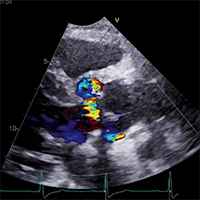Echocardiographic evaluation of paravalvular aortic regurgitation of a patient with recurrent aortic valve replacements

Submitted: January 11, 2021
Accepted: April 12, 2021
Published: April 21, 2021
Accepted: April 12, 2021
Abstract Views: 2637
PDF: 398
Publisher's note
All claims expressed in this article are solely those of the authors and do not necessarily represent those of their affiliated organizations, or those of the publisher, the editors and the reviewers. Any product that may be evaluated in this article or claim that may be made by its manufacturer is not guaranteed or endorsed by the publisher.
All claims expressed in this article are solely those of the authors and do not necessarily represent those of their affiliated organizations, or those of the publisher, the editors and the reviewers. Any product that may be evaluated in this article or claim that may be made by its manufacturer is not guaranteed or endorsed by the publisher.
Similar Articles
- Maria Rosario Piccirillo, Armando Natale, Giovanni Trosino, Marianna Sebastopoli, Giovanni Vivona, Giovanni De Martino, Gennaro Ismeno, Luigi Piazza, Luigi Belloni, What’s the best assessment of preload after cardiac surgery? , Monaldi Archives for Chest Disease: Vol. 64 No. 1 (2005): Cardiac series
- Savvas Omorphos, Christophoros Kotoulas, Jarrod James Homer, Kenneth Edward McLaughlin, Delayed repair of esophageal perforation due to transoesophageal echocardiography , Monaldi Archives for Chest Disease: Vol. 68 No. 4 (2007): Cardiac series
- Carlo Uran, Angela Giojelli, A "sneaky" symptom of aortic dissection. Brief literature review, physiopathology and diagnostic tools management , Monaldi Archives for Chest Disease: Vol. 91 No. 2 (2021)
- Maria Teresa Manes, Manlio Gagliardi, Gianfranco Misuraca, Stefania Rossi, Mario Chiatto, Left ventricular geometric patterns and cardiac function in patients with chronic renal failure undergoing hemodialysis , Monaldi Archives for Chest Disease: Vol. 64 No. 1 (2005): Cardiac series
- Ivano Bonadei, Enrico Vizzardi, Antonio D’Aloia, Edoardo Sciatti, Edoardo Cervi, Stefano Bonardelli, Marco Metra, Stefano Maria Giulini, A drastic complex atheromatous aorta A case report , Monaldi Archives for Chest Disease: Vol. 80 No. 1 (2013): Cardiac series
- Eduardo Bossone, Santi Trimarchi, Gloria Esposito, Stefano Aliberti, Rodolfo Citro, Luigi Allegra, Francesco Blasi, Chlamydia Pneumoniae and Acute Aortic Syndrome: A Call for a Multi-Institutional Study , Monaldi Archives for Chest Disease: Vol. 70 No. 2 (2008): Cardiac series
- Aladdin Bashir, Zaheer Tahir, Mahmood Ahmad, Kyriacos Mouyis, Ali Zuhair Kirresh, Sameh Atta, Clinton Lloyd, Malcolm Dalrymple-Hay, A decade’s summary of transcatheter tricuspid valve repair , Monaldi Archives for Chest Disease: Early Access
- Charalampos Chrysanthos Mylonas, Georgia Gomatou, Garyphallia Poulakou, Eleni Moraitou, Konstantinos Syrigos, Human disease caused by Streptococcus alactolyticus: a case report of native valve infective endocarditis and review of the literature , Monaldi Archives for Chest Disease: Vol. 90 No. 4 (2020)
- Christian Basile, Costantino Mancusi, Paola Gargiulo, Pasquale Perrone Filardi, Cinzia Perrino, Grazia Canciello, Maria Angela Losi, Giovanni Esposito, Aortic thrombosis: the forgotten source of ischemic stroke. A case report and systematic review of the literature , Monaldi Archives for Chest Disease: Vol. 92 No. 3 (2022)
- Maria Grazia Romeo, Emanuele Pilato, Raffaele Giordano, Giuseppe Comentale, Gabriele Iannelli, Domenico Romeo, Bruna Miserrafiti, Luigi Di Tommaso, Asymptomatic giant ascending aortic aneurysm: a challenging surgical strategy for a silent bicuspid aortopathy , Monaldi Archives for Chest Disease: Early Access
<< < 1 2 3 4 5 6 7 8 9 10 > >>
You may also start an advanced similarity search for this article.

 https://doi.org/10.4081/monaldi.2021.1765
https://doi.org/10.4081/monaldi.2021.1765





